Snake encounters are a common occurrence for every angler who bank walks in Australia. Prime fishing areas also mean, prime snake habitat.
There is likely to be an abundance of prey in the form of frogs and small mammals. Rivers, creeks and lakes also provide water, sun, shade and plenty of places to hide from predators. It is common sense that we should be aware of the risk snakes present as well as precautions that we can take to avoid being bitten. As a parent taking your children into these environments, there are a few extra factors you should consider to make your fishing adventure as safe and enjoyable as possible.
Note: To start with, I’d better throw in a disclaimer. I’m not a herpetologist or snake handler. I’ve got absolutely no medical training. This article is no substitute for a first aid course. All I really bring to the table is that I am a parent who enjoys doing adventurous stuff outside with my kids. I’ve also done a fair bit of river and creek walking. I’ve seen hundreds of snakes but have never been bitten or had to treat a snake bite.
Preventing a Snake Bite
There are 3 parts to this;
1. Keeping a lookout for snakes. This involves being constantly vigilant in terms of looking where you are going and where you place your hands and feet. Children are much less reliable than adults in this regard. Every time we go for a flick I’ll remind my child that they are in a “snaky” area, to be careful in long grass, and to check where they are putting their feet when stepping over logs and rocks. I also remind them not to put hands in hollow logs or trees. A particularly risky situation is bush camping. Once relaxed and comfortable at a campsite children tend to run amok. While it is great to see them glorying in the exuberance and vitality of their youth, they are much more likely to step on something they shouldn’t.
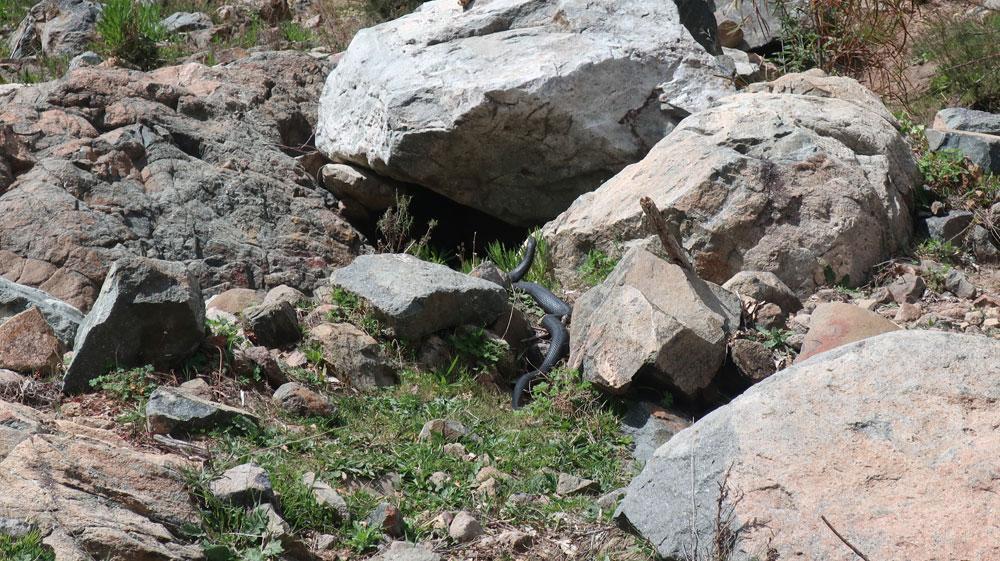
A Red Bellied Black soaking up the warm sun in close to rocks. Always be careful around rocks as these are common areas at snakes will sit and sun bake.
2. Wear appropriate clothing. Enclosed shoes are a must. Gumboots are good in some situations but can be hazardous if a child wears them in deep water. Almost all snakebites involving fisherman and bushwalkers are on the feet or lower leg. I put my kids in a pair of gaiters that cover ankles and shins. There is also a strong argument to wear long pants. On a hot day you will have to tradeoff with comfort. Most of the time I’d have my kids wear a pair of light weight nylon travel type pants. These offer less protection than jeans or thicker trousers but are much more practical when walking in water. On the plus side venomous snakes in South Eastern Australia have very small fangs so are less likely to puncture clothing.
3. Make sure they know what to do if they encounter a snake. This is actually a highlight for my kids. If you are 10 metres away, it is easy to admire this sleek and graceful creature as it slithers away. You will probably feel differently if there is a brown jack-in-the-box right next to your child’s bare leg. If you see a snake and it’s a reasonable distance away, its best to stop and keep still. Nine times out of 10, it will move away on its own accord. If it doesn’t, just walk around it, giving it a wide berth. The scary interactions are when you first notice a snake as you are right on top of it. Again, most of the time, the snake will bolt. If its holds its ground and looks excited, instruct your child to keep very still. If it hasn’t retreated after a reasonable time, instruct your child to back away very slowly. It goes without saying that you and your children should never interfere with a snake. Don’t try to kill it or pick it up. Harassing a snake in any way massively increases your chances of being bitten.
What to do if Your Child is Bitten
If your child is bitten by a snake, remember that you are dealing with a medical emergency. This is going to be a scary and traumatic experience for both parent and child. The good news is that snake bite deaths in Australia are rare (approximately 2 per year). With the correct first aid and prompt medical attention the chance of a good outcome is high.
To ensure a good outcome you need to ensure you have the proper equipent. When fishing in snake country the minimum I’d carry is two broad compression bandages, a rescue beacon (Personal Locator Beacon) and a mobile phone. Basic first aid for snakebite is relatively simple …
- KEEP THE PATIENT STILL,
- Apply a pressure immobilization bandage and;
- get medical help ASAP.
If a child is involved and you are in a remote area, things can get more complicated. As a parent in this situation you may have to make some judgement calls, which will depend on the specific circumstances.
It is useful to understand how venom moves around the body and what the first aid you have administered is trying to achieve.
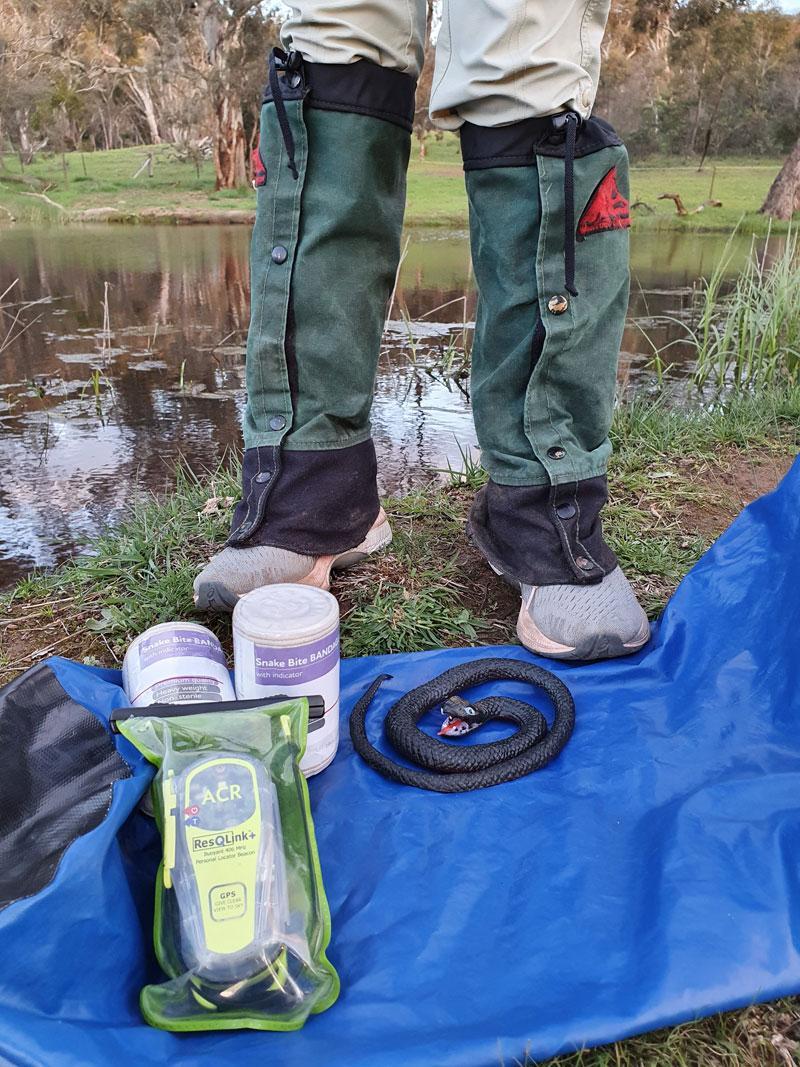
The essentials in a snake bite kit for kids: two broad compression bandages, a rescue beacon (PLB) and gators to protect the legs.
What Happens to your Body When Bitten?
When a snake bites, any venom will be deposited in the fluid within the body’s tissue and not directly into blood vessels. This fluid is part of the lymphatic system. Movement of the venom is dependent on movement and contraction of surrounding muscles. The pressure immobilization bandage is slowing the movement of the venom, buying you time to get the patient to medical professionals who can administer antivenin. This is really important in children because due to their small size, even a small amount of venom reaching their bloodstream could potentially overwhelm them. Also, a scared and unwell child is going to be much more difficult to keep still than an adult patient. As a parent your challenge is how to get your child to hospital as quickly as possible with as little movement as possible.
If you are faced with a potential snake bite you will need to go through the following steps;
Step 1 – Remove Danger. Make sure your child, yourself and anyone else in your fishing party is well away from the snake. The last thing you need is a second casualty.
Step 2 – Assess the injury. Sit your child down and instruct them to KEEP STILL. Reassure them. Ask them if and where the snake bit or touched them. Is there any pain? Have a really good look for any puncture marks or scratches. Even the smallest scratch could be evidence of envenomation. Try and stay as calm as possible.
If you believe there is any chance of your child has been bitten then…
Step 3 – Apply a Pressure Immobilization Bandage. First apply a bandage over the bite site, to an area about 10cm above and below the bite. Then firmly wind another bandage up the limb starting at the toes/fingers and going all the way to the top of the leg/arm. When I say firmly I mean the tighter side of firm but not excessively tight (as firm as for a sprained ankle). This bandage MUST NOT be removed until your child gets to hospital unless there are signs of reduced blood supply to the limb. If this occurs reapply the bandage with a little less pressure. Put a mark on the bandage to clearly indicate the location of the actual bite. This will allow doctors at the hospital to swab for venom without removing the whole bandage.
Step 4 – Immobilization. Immobilize the joints on either side of the bite site using a splint. Sticks and duct tape work well. Also immobilize the child by lying them down and reassuring them to keep movement to a minimum.
Step 5 – Call for help. If you have mobile reception dial 000. Put the phone on speaker and make the call while you are applying the pressure immobilization bandage. The emergency operator should be able to advise on the application of the bandage and help work out the quickest and safest way to get your child to hospital. If you are easily accessible to a road ambulance then at this stage you can probably sit back, monitor your child and wait for the cavalry.
If you do not have mobile reception you are going to have to decide how to get your child to hospital. If it was a very short easy carry to the car and a straightforward drive, I’d probably drive them myself. The reasoning here is they would get to hospital much quicker than waiting for rescue. Don’t let them walk. Even when you are carrying them their muscles will still be working, increasing the movement of venom. Slow and gently is the way to go. During the drive call ahead as soon as you have mobile reception to confirm the hospital has the required antivenin and resources.
If I was in rough country away from the car, I would not hesitate to activate the rescue beacon as soon as I had finished applying the bandage and splint. When applied correctly a pressure immobilization bandage is highly effective at slowing the movement of venom. You would most likely have bought yourself at least several hours. Keeping your child still and waiting for a helicopter evacuation will always be a better option than man handling your child through rough terrain.
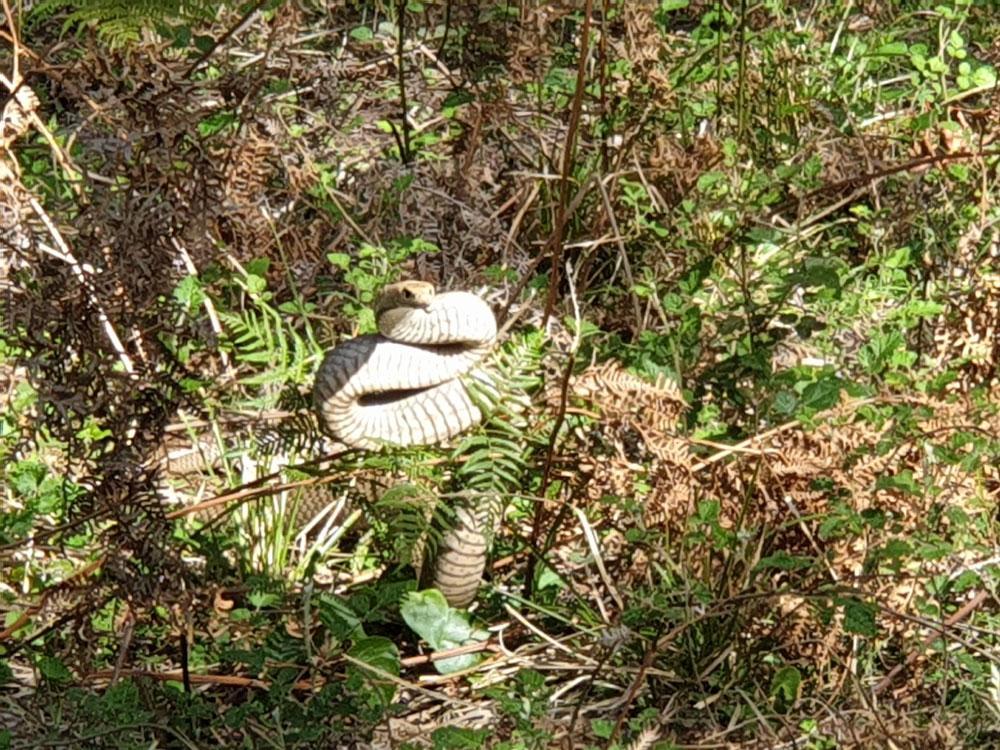
An angry Brown Snake ready to attack. If you ever see a snake do this, stop and slowly back away. Leaving the snake alone. Pic: Sharyn Wragg.
Debunking a Few Snake Myths
Snakes are aggressive creatures that are out to kill you – Snakes probably think you are trying to eat them and will almost always try to avoid you. Very occasionally a snake might be aggressively defensive. This is usually if it feels cornered or someone steps on it or intentionally harasses it.
You need to capture or kill a snake to help the medics identify it – All this does is increase the risk of someone else being bitten. My wife who works in the hospital system was once presented with a frozen Tiger Snake head by a concerned relative of one of her patients. There is now a single antivenin that neutralizes the venom of all Australian snakes. There is no reason to try and catch a snake for identification purposes as it will not change treatment.
It is only a Python so its ok to pick up to impress the kids –Don’t do this! It is easy to confuse venomous and non-venomous snakes. Broad Headed Snakes (dangerous) can look a lot like Diamond Pythons. Even non-venomous snakes carry nasty bacteria in their saliva which can lead to infections.
If you get bitten by a snake go to the vet as they treat more snakebites – vets do not have the same level of training as medical doctors and will not have the appropriate equipment to treat humans. Asking them to treat a person would be a medicolegal nightmare for them. Just call an ambulance and get to a hospital.
It is only a baby snake so I will be alright – juvenile snake’s venom can be just as potent as an adult snake’s.
I’m old school so I will “cut and suck” – all you are really doing is putting a really toxic substance in your mouth.
Dry and Wet Bites – depending on species it is estimated that up to 50% of bites do not involve envenomation. This is useful information to convey when reassuring a casualty but always apply first aid as if envenomation occurred.
Snake bites are always painful – I’m sure they can be but not always. There have been cases where people have been bitten and have not realized it. So if you are fishing in snake country and you or your child starts getting unexplained nausea, headaches, muscle weakness or breathing difficulties consider snakebite as a possibility, look for puncture marks or scratches and apply first aid as appropriate.
Snakes only come out in hot weather – snakes are more active in spring and summer. You tend to start seeing them when the yellas start biting. It might be something to do with them being hot and hungry. However, snakes don’t actually hibernate and can be encountered any time of year.
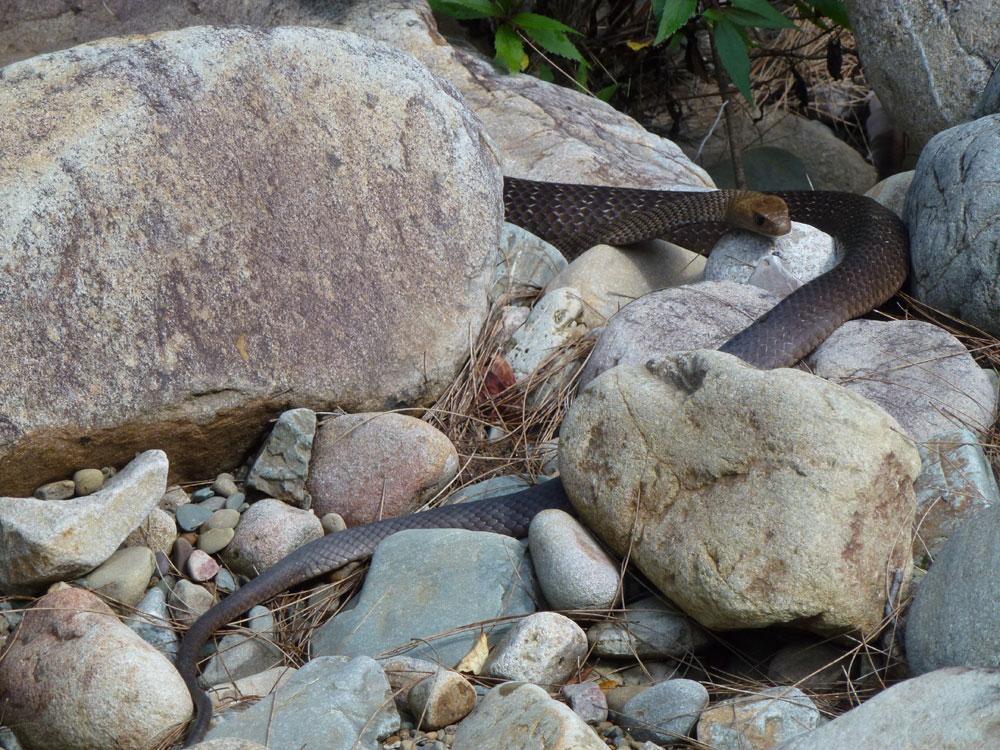
It's common to find snakes close to water so make sure you're always on the lookout and watch where you step.
Other Useful Tools
There are other techie toys that may provide further piece of mind when you are taking your kids fishing in the backcountry;
- Satellite Phone – allows you to make phone calls when you have no mobile signal. I don’t think many fishos use them as they are expensive (purchase price + monthly subscription fee)
- GPS Communication Devices – Depending on the functionality of the particular model these allow you to send and receive emails and texts via satellite, allow contacts to track your location via GPS and have an SOS button for emergencies. These are potentially cheaper than sat phones but still require a monthly subscription fee. Reputable brands include Garmin, Spot and Zoleo.
- Emergency Apps – The Emergency+ app uses GPS functionality built into your smart phone to give your location details to emergency services during a 000 call.
Personally, I’ve never let a fear of snakes stop me going on a walking or fishing trip. Since I’ve started to go out with my children I put a lot more thought into snake bite risk, precautions and contingency plans. With a bit of planning and the right kit there is no reason you can’t take your kids fishing regardless of the presence of slithering serpentines.
Written by Ganguddy Goodoo
‘Ganguddy Goodoo has been fishing for 3 years. His home turf is Canberra’s urban lakes and the Murrumbidgee. He spends most of his time trying to get his children off Minecraft and outside doing something active and adventurous. Before he started fishing he spent about 30 years bushwalking and climbing. Once the young ones are a bit more self sufficient he would like to revisit some remote rivers and creeks in the Blue Mountains and Australian Alps with a fly rod.’


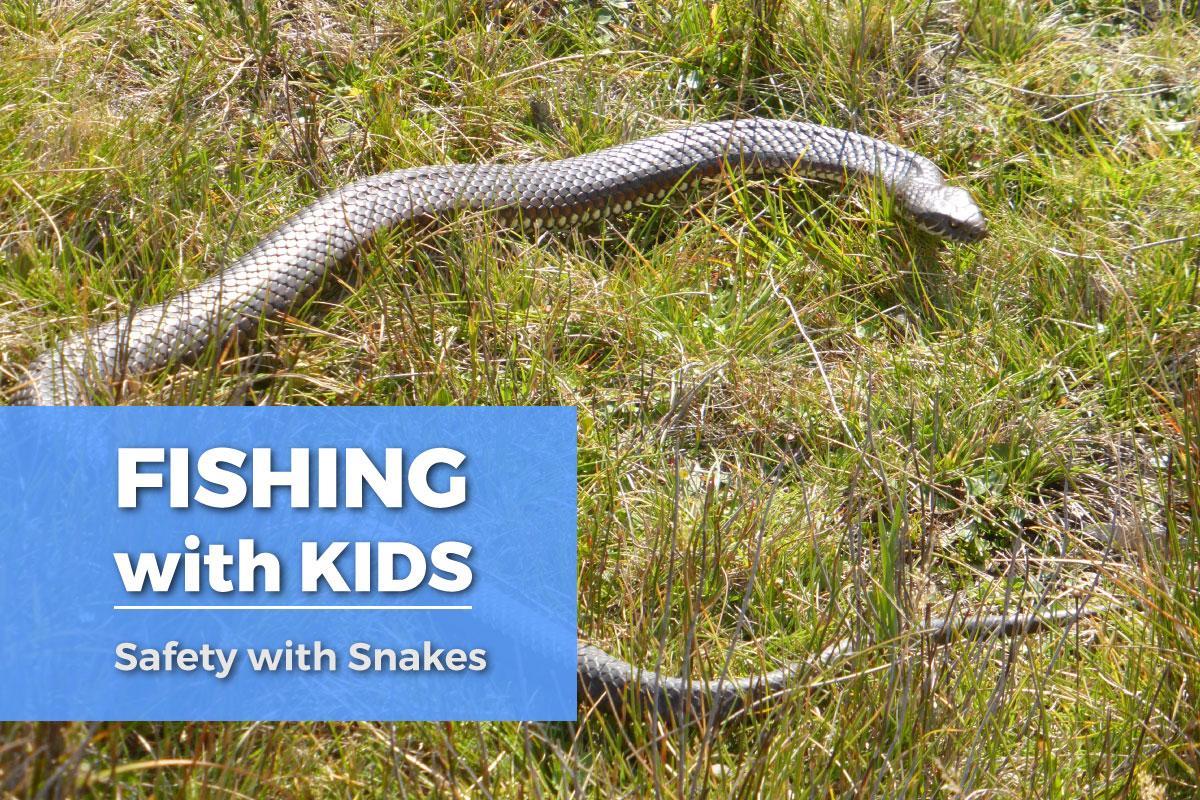
0 comments